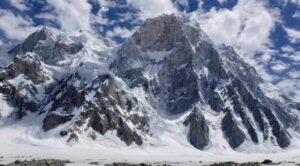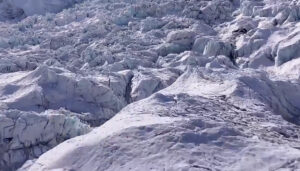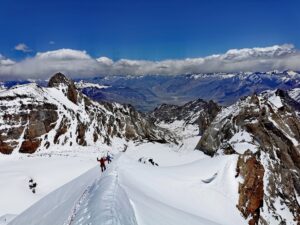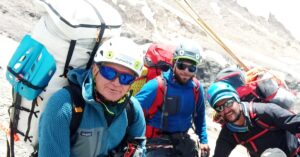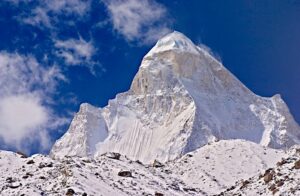Beyond the intrinsic value of the activity itself, adventure has always been a game of firsts. By the late 1970s, high-altitude mountaineering had somewhat moved away from first ascents to focus on the style and difficulty of new routes. Siege-style expeditions made way for smaller, more nimble teams, tackling technically more challenging ground.
The zeitgeist of Himalayan climbing at the time was a yearning for faster, lighter travel. Although climbers and physiologists both thought it impossible, the next step was to venture to the summit of Everest without supplementary oxygen. Ever since Edward Norton got within 300m of the summit without oxygen in 1924, the sliver of possibility was there.
That sliver was enough to tempt the hotshot European pair of Reinhold Messner and Peter Habeler to go for it. They were known for charging up alpine test-pieces, had a number of 8,000m summits between them, and in 1975, they had climbed Gasherbrum I without oxygen. Even so, Everest was considered just too high, the air “too thin”, according to the medical community. Despite widespread skepticism, they summited without oxygen (incredibly fast, it should be noted) in the spring of 1978.

Messner and Habeler on Everest, 1978.
Just as when Roger Bannister broke the four-minute mile, the gates of possibility now opened for other elite climbers. The limits of human physiology and of the human spirit had been stretched. But that doesn’t mean it was going to be easy for others to replicate. After all, Habeler had almost crawled the last 100m to the summit, and Messner had so vividly described the knife-edge that the two men trod: “I no longer belong to myself and to my eyesight. I am nothing more than a single, narrow gasping lung, floating over the mists and summits.”
Not content with this landmark moment, Messner strove for another in the monsoon of 1980. Everest sans oxygen, but this time alone and from the North. Just him, the mountain, and his pregnant girlfriend at Base Camp. Not even a liaison officer shuffling papers down on the East Rongbuk Glacier. He would be the solitary witness to his efforts.
Trying to take advantage of more settled post-monsoon weather, and as the story goes, to pip a solo attempt from Japanese climber Naomi Uemura, he brought his schedule forward. It still allowed for around a month of training on the Tibetan plateau, readying for another oxygen-less effort in the Death Zone.
After some acclimatization and the depositing of supplies on the North Col, Messner set off for the summit on August 18, 1980. Within a few hours of leaving Advanced Base Camp, he toppled into a crevasse at night, at over 7,000m. Lucky to be alive, Messner hauled himself out and continued upward along the North Ridge.
The next day, he beelined about two kilometres across the huge and avalanche-prone North Face to reach the Great (also known as Norton) Couloir. Here, he hunkered down for a bivouac at around 8,200m. A tiny speck up there, alone and out of reach. He might as well have been on the moon. By 1 pm the following day, Messner had pushed his exhausted body up through the couloir to the roof of the world — on the third day since leaving Base Camp. The first person to stand truly alone on the summit. August 20, 1980.

Everest summit solo, 1980. Photo: Reinhold Messner
Later, Messner described what his time on the summit was like. He said, “I was in continual agony; I have never in my whole life been so tired as on the summit of Everest that day. I just sat and sat there, oblivious to everything…I knew I was physically at the end of my tether.”
After a night back at the base of the Great Couloir, he dumped his kit and sped down to Advanced Base Camp, intent on making it in one push. Of his eventual return to safety, his girlfriend, Nena Holguin, later wrote in her diary, “It seems that a drunk came down from the col and not the same man who left four days ago. He looks at me with tears in his eyes. His face is yellow, his lips are chapped and frayed.”
Alone, without oxygen, on dangerous terrain, without hope of rescue, and at the very limits of known human endurance, Messner risked it all for a dream, a fleeting moment atop the roof of the world. To prove it was possible.
Even the most ardent of critics of Messner, who is sometimes accused of unnecessary hubris, must accept that the motivation and spirit required were extraordinary. A physical and mental feat to match the four-minute mile and what mountaineering author John Krakauer has described as “a deed widely regarded as the greatest mountaineering feat of all time.”

Nanga Parbat solo, 1978. Photo: Reinhold Messner Collection
The pioneering American Everest climber Tom Hornbein captured the feelings among the mountaineering community at the time when he said, “Like Copernicus, Messner had conceived a whole new way of seeing his world. He transformed mountaineering as we know it.”
It also acted as a catalyst for the next stage in Messner’s own career. It gave him the confidence and knowledge that he could go on to become the first person to climb all the 8,000’ers, and to do it without oxygen.
Fellow legendary high-altitude climber Doug Scott also contextualizes the climb’s impact well. “Reinhold, phenomenally strong and so highly motivated and experienced, was able to do that supreme thing of climb Everest completely solo, from the north, partly by a new route, with only his pregnant girlfriend in support.
“Most of us who were going out regularly and doing new things were just taking a little step up on the backs of those who went before. But Reinhold really did take quite a big step. Quite a leap,” said Scott.
Messner’s climb was considered a landmark in the history of mountaineering four decades ago, and it would still be considered a major achievement today. Few climbers summit without oxygen and even fewer climb truly solo.
All of our top ten expeditions took steps into the unknown, be it geographically, physically, or mentally. But the first solo summit of the highest point on earth one afternoon 40 years ago, is arguably the most audacious, bold, and visionary.


